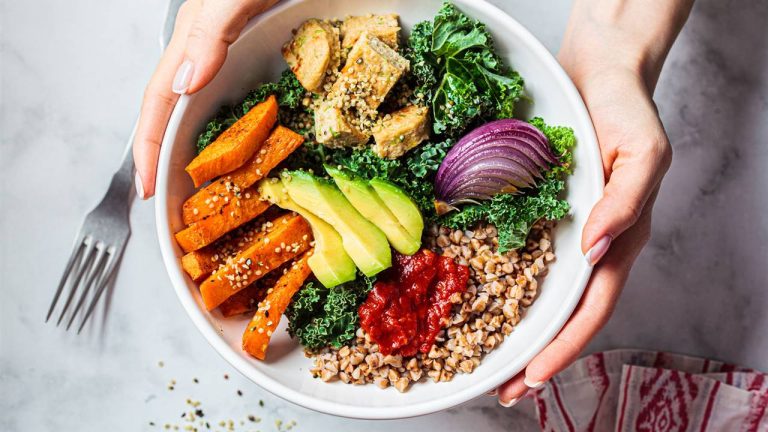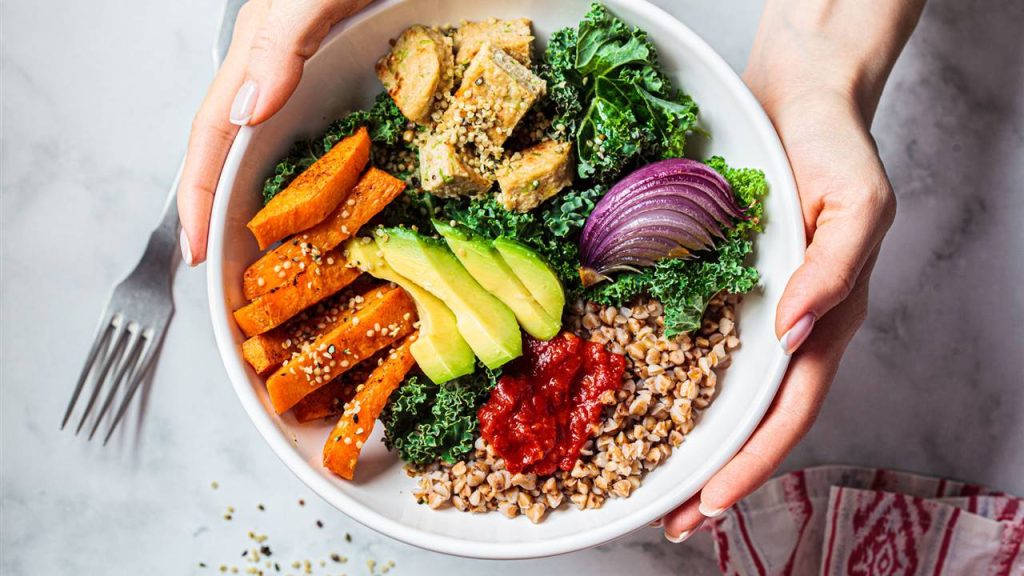
Protein isn’t just good for building muscle or losing weight if you avoid carbs. They are an indispensable nutrient in any balanced diet. We give you the keys to get the necessary ones, with an example weekly menu.

Getting all the protein we need is vital for physical energy, mental balance and powerful immunity. However, when trying it many doubts can arise, whether you follow an omnivorous diet, in which sometimes proteins are present in excess, or if you follow a vegetarian diet, in which it is convenient to know what its main sources are.
Here we tell you why proteins are so necessary, in what quantity they are needed and how to obtain them with plant foods. This is essential when following a vegetarian diet, but also when you are not vegetarian, because vegetable proteins should also be very present in the menus of this other type of diet.
You will find some tricks to enrich your dishes and an example of a weekly menu with protein in all dishes, so that you do not lack ideas and you can ensure the necessary proteins with healthy dishes, full of vegetables.
WHAT ARE PROTEINS FOR?
Proteins are large, complex molecules composed of amino acids. In nature we find 22 amino acids, of which ten are considered essential for human health. An essential amino acid is one that our body cannot synthesize on its own, and that is why we must get it through food.
These essential amino acids are necessary for the proper development of many physiological processes in the body:
- Immune function: Proteins play a crucial role in our body as constituents of the immune system, since the antibodies responsible for neutralizing the antigens present in bacteria, viruses and other microorganisms, which can cause potentially serious infections, are proteins.
- They form the tissues: All cell membranes are lattices of proteins and fats. In addition, proteins are involved in repair processes of damaged tissues. We find different types of proteins as constituents of various tissues, such as, for example, keratin of nails and hair, myosin of muscles or collagen of the skin, connective tissue, cartilage and bones.
- Basic for metabolism: Amino acids fulfill a regulatory function, since they intervene in a wide variety of chemical processes that allow digestion, respiration, calcium and phosphorus metabolism, iron transport, the formation of new cells, the formation and renewal of DNA, the use of energy by cells and the formation of enzymes and hormones.
- Power source: Protein is also a source of energy for our body. Although the basic sources of energy are carbohydrates and fats, in cases of nutritional deficit or malnutrition the body can degrade proteins (especially muscle) for energy.
WHAT ARE THE ESSENTIAL AMINO ACIDS?
The essential amino acids that we have to get through food are ten:
- Leucine
- Isoleucine
- Valine
- Methionine
- Lysine
- Phenylalanine
- Tryptophan
- Threonine
- Histidine
- Arginine
Histidine is considered essential in childhood, but not in adulthood (however, it is usually included in lists of essential amino acids).
On the other hand, arginine can be synthesized by the body, but it is essential for premature babies and for adults recovering from an injury, burn or infection, or who suffer alterations in the small intestine or kidneys.
HOW MANY GRAMS OF PROTEIN ARE NEEDED PER DAY
We have to get the ten essential amino acids from food. To meet our daily needs for all these essential amino acids, the World Health Organization recommends that adults get a minimum of 0.8 g of protein per kilogram of body weight per day from food.
However, this recommendation is general and for sedentary people. Actual needs are conditioned by total energy intake, weight, body composition and level of physical activity.
In addition, the requirements are greater during childhood, pregnancy, lactation or convalescence after injuries or surgical interventions.
In conclusion, a healthy and physically active person may need between 1.5 and 2 g of protein per kilogram of body weight. For a 60kg woman this means that she should consume between 90 and 120 g of protein a day.
WHAT ARE THE SYMPTOMS THAT YOU ARE MISSING PROTEIN?
Among the symptoms of deficiency, we find inability to form muscle mass, tendency to suffer injuries and infections, aged appearance of the skin and hair or fragile nails are some signs that our body needs more protein in the day to day.
Protein deficiency can also manifest with depressed mood, mood swings, tiredness, dissatisfaction, and difficulty concentrating.
HOW TO GET PROTEIN IN A VEGETARIAN DIET
Protein-rich foods provide a feeling of fullness and do not increase blood glucose levels. In the right proportions, they should be part of the balanced diet and special care should be taken to their presence in sufficient quantities in slimming or blood sugar control regimes.
If an ovolacto-vegetarian diet is carried out, the main sources of protein are the following:
- Cooked legumes (chickpeas, lentils, beans, etc.) provide about 18 g of protein per 200 g serving.
- Firm tofu provides 19 g per 150 g serving.
- Whole grains and pseudocereals, such as cooked buckwheat, quinoa or wheat pasta, contain 8-9 g of protein per 150 g serving.
- Cooked brown rice provides 4.5 g per 150 g serving.
- Nuts and seeds contain 4.5 g of protein per 30 g of product.
- An egg weighing 50 g contains 6 g of protein.
In addition, we must not neglect the proteins provided by vegetables. For example, a 200 g serving of broccoli or steamed green beans contains up to 5 g of protein.
Taking into account these figures, we can get the proteins we need by combining food in the right proportions, according to the weight of each one and the level of physical activity demand.
HOW TO INCREASE THE ABSORPTION OF PLANT PROTEINS
To assimilate the amino acids provided by plant foods, it is advisable to combine throughout the day the widest possible variety of sources: legumes, cereals, nuts, seeds, vegetables …
In addition, soaking legumes, cereals, nuts and seeds also helps.
PROTEIN-RICH FOODS TO ENRICH YOUR DISHES
In the vegetarian diet some foods can be very useful to add a contribution of extra protein to the dishes:
- Soy tempeh: It is a very interesting food since it contains all the essential amino acids in adequate proportions for a good use. It is also very easy to prepare grilled. You can accompany it with a little mustard or add it to a stew with artichokes. 100g of soy tempeh provides 12 g of protein.
- Fresh peas: The pea is a legume, but we consume it as if it were a vegetable. A serving of 200 g of steamed peas provides no less than 12 g of protein (this is more than 50 g of chicken, for example).
- Quinoa and buckwheat: These foods are perfect for preparing salads, stuffing vegetables or making hamburgers.
Spirulina: It is a freshwater microalga that contains all the essential amino acids, plus calcium and iron. It can be incorporated into powder juices and smoothies. One tablespoon provides 4 g of protein.
DOWNLOADABLE MENU: WEEKLY VEGETARIAN MENU RICH IN PROTEIN
In the vegetarian diet, legumes, in one form or another, are present almost daily. It also frequently includes nuts and seeds. In this downloadable menu you will find proteins in all dishes, distributed in a balanced way, thanks to the presence of varied foods that will help you obtain all the essential amino acids.